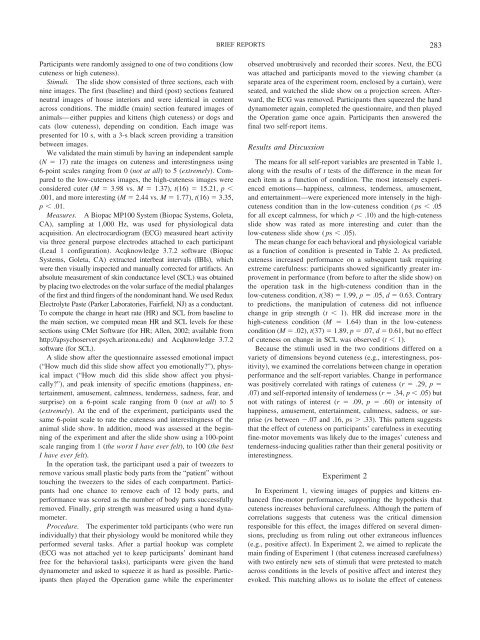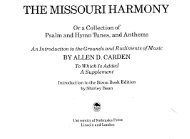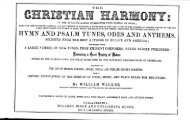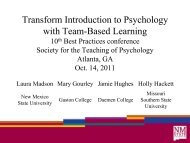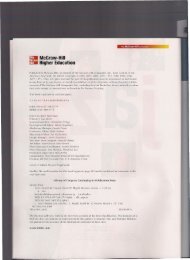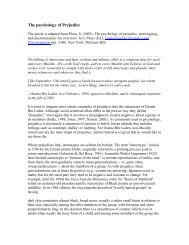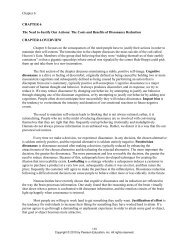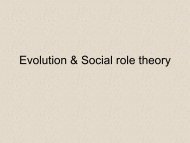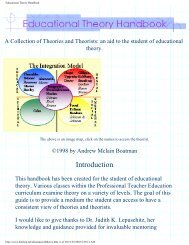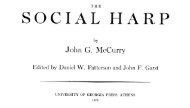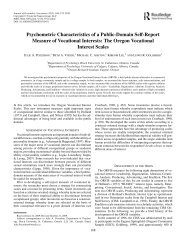Sherman Haidt Coan -- Cuteness and Carefulness
Sherman Haidt Coan -- Cuteness and Carefulness
Sherman Haidt Coan -- Cuteness and Carefulness
Create successful ePaper yourself
Turn your PDF publications into a flip-book with our unique Google optimized e-Paper software.
Participants were r<strong>and</strong>omly assigned to one of two conditions (low<br />
cuteness or high cuteness).<br />
Stimuli. The slide show consisted of three sections, each with<br />
nine images. The first (baseline) <strong>and</strong> third (post) sections featured<br />
neutral images of house interiors <strong>and</strong> were identical in content<br />
across conditions. The middle (main) section featured images of<br />
animals—either puppies <strong>and</strong> kittens (high cuteness) or dogs <strong>and</strong><br />
cats (low cuteness), depending on condition. Each image was<br />
presented for 10 s, with a 3-s black screen providing a transition<br />
between images.<br />
We validated the main stimuli by having an independent sample<br />
(N 17) rate the images on cuteness <strong>and</strong> interestingness using<br />
6-point scales ranging from 0 (not at all) to5(extremely). Compared<br />
to the low-cuteness images, the high-cuteness images were<br />
considered cuter (M 3.98 vs. M 1.37), t(16) 15.21, p <br />
.001, <strong>and</strong> more interesting (M 2.44 vs. M 1.77), t(16) 3.35,<br />
p .01.<br />
Measures. A Biopac MP100 System (Biopac Systems, Goleta,<br />
CA), sampling at 1,000 Hz, was used for physiological data<br />
acquisition. An electrocardiogram (ECG) measured heart activity<br />
via three general purpose electrodes attached to each participant<br />
(Lead 1 configuration). Acqknowledge 3.7.2 software (Biopac<br />
Systems, Goleta, CA) extracted interbeat intervals (IBIs), which<br />
were then visually inspected <strong>and</strong> manually corrected for artifacts. An<br />
absolute measurement of skin conductance level (SCL) was obtained<br />
by placing two electrodes on the volar surface of the medial phalanges<br />
of the first <strong>and</strong> third fingers of the nondominant h<strong>and</strong>. We used Redux<br />
Electrolyte Paste (Parker Laboratories, Fairfield, NJ) as a conductant.<br />
To compute the change in heart rate (HR) <strong>and</strong> SCL from baseline to<br />
the main section, we computed mean HR <strong>and</strong> SCL levels for these<br />
sections using CMet Software (for HR; Allen, 2002; available from<br />
http://apsychoserver.psych.arizona.edu) <strong>and</strong> Acqknowledge 3.7.2<br />
software (for SCL).<br />
A slide show after the questionnaire assessed emotional impact<br />
(“How much did this slide show affect you emotionally?”), physical<br />
impact (“How much did this slide show affect you physically?”),<br />
<strong>and</strong> peak intensity of specific emotions (happiness, entertainment,<br />
amusement, calmness, tenderness, sadness, fear, <strong>and</strong><br />
surprise) on a 6-point scale ranging from 0 (not at all) to 5<br />
(extremely). At the end of the experiment, participants used the<br />
same 6-point scale to rate the cuteness <strong>and</strong> interestingness of the<br />
animal slide show. In addition, mood was assessed at the beginning<br />
of the experiment <strong>and</strong> after the slide show using a 100-point<br />
scale ranging from 1 (the worst I have ever felt), to 100 (the best<br />
I have ever felt).<br />
In the operation task, the participant used a pair of tweezers to<br />
remove various small plastic body parts from the “patient” without<br />
touching the tweezers to the sides of each compartment. Participants<br />
had one chance to remove each of 12 body parts, <strong>and</strong><br />
performance was scored as the number of body parts successfully<br />
removed. Finally, grip strength was measured using a h<strong>and</strong> dynamometer.<br />
Procedure. The experimenter told participants (who were run<br />
individually) that their physiology would be monitored while they<br />
performed several tasks. After a partial hookup was complete<br />
(ECG was not attached yet to keep participants’ dominant h<strong>and</strong><br />
free for the behavioral tasks), participants were given the h<strong>and</strong><br />
dynamometer <strong>and</strong> asked to squeeze it as hard as possible. Participants<br />
then played the Operation game while the experimenter<br />
BRIEF REPORTS<br />
observed unobtrusively <strong>and</strong> recorded their scores. Next, the ECG<br />
was attached <strong>and</strong> participants moved to the viewing chamber (a<br />
separate area of the experiment room, enclosed by a curtain), were<br />
seated, <strong>and</strong> watched the slide show on a projection screen. Afterward,<br />
the ECG was removed. Participants then squeezed the h<strong>and</strong><br />
dynamometer again, completed the questionnaire, <strong>and</strong> then played<br />
the Operation game once again. Participants then answered the<br />
final two self-report items.<br />
Results <strong>and</strong> Discussion<br />
The means for all self-report variables are presented in Table 1,<br />
along with the results of t tests of the difference in the mean for<br />
each item as a function of condition. The most intensely experienced<br />
emotions—happiness, calmness, tenderness, amusement,<br />
<strong>and</strong> entertainment—were experienced more intensely in the highcuteness<br />
condition than in the low-cuteness condition ( ps .05<br />
for all except calmness, for which p .10) <strong>and</strong> the high-cuteness<br />
slide show was rated as more interesting <strong>and</strong> cuter than the<br />
low-cuteness slide show ( ps .05).<br />
The mean change for each behavioral <strong>and</strong> physiological variable<br />
as a function of condition is presented in Table 2. As predicted,<br />
cuteness increased performance on a subsequent task requiring<br />
extreme carefulness: participants showed significantly greater improvement<br />
in performance (from before to after the slide show) on<br />
the operation task in the high-cuteness condition than in the<br />
low-cuteness condition, t(38) 1.99, p .05, d 0.63. Contrary<br />
to predictions, the manipulation of cuteness did not influence<br />
change in grip strength (t 1). HR did increase more in the<br />
high-cuteness condition (M 1.64) than in the low-cuteness<br />
condition (M .02), t(37) 1.89, p .07, d 0.61, but no effect<br />
of cuteness on change in SCL was observed (t 1).<br />
Because the stimuli used in the two conditions differed on a<br />
variety of dimensions beyond cuteness (e.g., interestingness, positivity),<br />
we examined the correlations between change in operation<br />
performance <strong>and</strong> the self-report variables. Change in performance<br />
was positively correlated with ratings of cuteness (r .29, p <br />
.07) <strong>and</strong> self-reported intensity of tenderness (r .34, p .05) but<br />
not with ratings of interest (r .09, p .60) or intensity of<br />
happiness, amusement, entertainment, calmness, sadness, or surprise<br />
(rs between .07 <strong>and</strong> .16, ps .33). This pattern suggests<br />
that the effect of cuteness on participants’ carefulness in executing<br />
fine-motor movements was likely due to the images’ cuteness <strong>and</strong><br />
tenderness-inducing qualities rather than their general positivity or<br />
interestingness.<br />
Experiment 2<br />
283<br />
In Experiment 1, viewing images of puppies <strong>and</strong> kittens enhanced<br />
fine-motor performance, supporting the hypothesis that<br />
cuteness increases behavioral carefulness. Although the pattern of<br />
correlations suggests that cuteness was the critical dimension<br />
responsible for this effect, the images differed on several dimensions,<br />
precluding us from ruling out other extraneous influences<br />
(e.g., positive affect). In Experiment 2, we aimed to replicate the<br />
main finding of Experiment 1 (that cuteness increased carefulness)<br />
with two entirely new sets of stimuli that were pretested to match<br />
across conditions in the levels of positive affect <strong>and</strong> interest they<br />
evoked. This matching allows us to isolate the effect of cuteness


